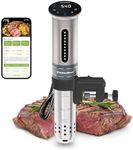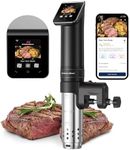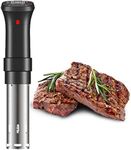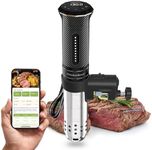Buying Guide for the Best Sous Vides
Choosing the right sous-vide machine can make a big difference in your cooking experience, especially if you want to achieve restaurant-quality results at home. Sous-vide cooking involves sealing food in a bag and cooking it in a water bath at a precise temperature for a set period of time. The key to picking the best sous-vide for you is understanding your cooking habits, the types of food you want to prepare, and how much control and convenience you need. By focusing on a few important specifications, you can find a sous-vide that fits your kitchen and your style.Temperature AccuracyTemperature accuracy refers to how closely the sous-vide machine can maintain the water at your chosen temperature. This is important because sous-vide cooking relies on precise temperatures to achieve perfect doneness and texture. Machines with higher accuracy (within 0.1°C or 0.2°F) are ideal for delicate foods like eggs or fish, while less precise models (within 1°C or 2°F) may be fine for tougher cuts of meat. If you plan to cook a variety of foods or want consistent results, look for a machine with high temperature accuracy.
Water CirculationWater circulation describes how the sous-vide device moves water around the container to ensure even temperature throughout. Some machines use a pump to circulate water, while others rely on convection. Stronger circulation (measured in liters per minute) helps maintain uniform heat, which is especially important when cooking larger quantities or thicker cuts. If you often cook for several people or want to avoid hot or cold spots, choose a sous-vide with robust water circulation.
Power (Wattage)Power, measured in watts, determines how quickly the sous-vide can heat the water and how well it maintains temperature, especially in larger containers. Lower wattage (around 800-900W) is suitable for small batches or occasional use, while higher wattage (1000W or more) is better for frequent cooking or larger volumes. If you plan to cook big meals or want faster preheating, a higher wattage model will be more efficient.
CapacityCapacity refers to the maximum amount of water the sous-vide can effectively heat and circulate. This is important if you plan to cook for a crowd or prepare multiple portions at once. Smaller units may handle up to 10 liters, while larger ones can manage 20 liters or more. Consider your typical batch size—if you mostly cook for one or two, a smaller capacity is fine, but for family meals or entertaining, a larger capacity is more practical.
Controls and ConnectivityControls and connectivity describe how you interact with the sous-vide machine. Some have simple manual dials or buttons, while others offer digital displays, timers, or even smartphone app control via Wi-Fi or Bluetooth. If you like to monitor or adjust your cooking remotely, or want to set precise times and temperatures easily, look for models with advanced controls and connectivity. For straightforward cooking, basic controls may be all you need.
Size and PortabilitySize and portability refer to the physical dimensions and weight of the sous-vide device. Compact, lightweight models are easier to store and move, making them ideal for small kitchens or occasional use. Larger, heavier units may offer more features or capacity but require more counter or storage space. Think about where you'll use and store your sous-vide, and choose a size that fits your kitchen and lifestyle.
Noise LevelNoise level is how much sound the sous-vide machine makes while operating, mainly from the water pump or fan. Quieter models are more pleasant to use, especially if your kitchen is close to living areas or you plan to run the machine for long periods. If noise is a concern for you, look for user reviews or manufacturer information about the machine's sound output.
















